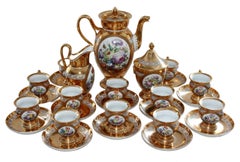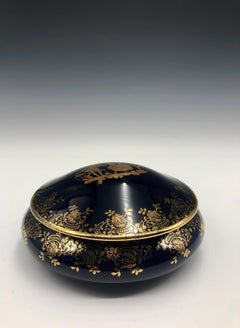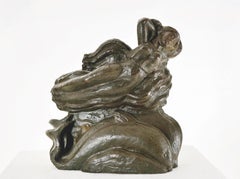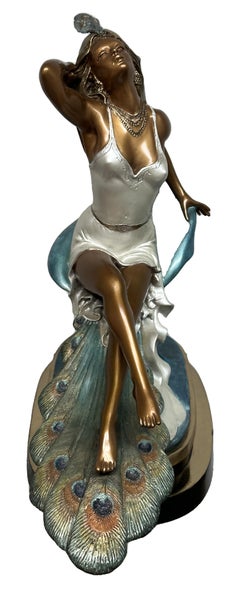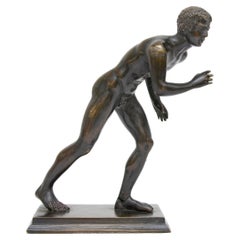Baroque Sculptures
to
3
5
4
4
1
3
1
Overall Height
to
Overall Width
to
604
583
552
218
106
72
66
63
31
21
5
4
2
1
6
5
3
3
2
1
1
1
1
1
1
1
1
1
1
1
22
11
9
25
3
2
3
7
7
7
2
2
Style: Baroque
Period: 20th Century
Tea Set for 12 persons 1949, porcelain, gilding, initials G.D.
Located in Riga, LV
Tea Set for 12 persons 1949, porcelain, gilding, initials G.D.
Cup h 7.5 cm; d 7.3 cm
Dish with lid h 17 cm
Creamer h 18.5 cm
Teapot h 27.5 cm
Category
1940s Baroque Sculptures
Materials
Porcelain
Vintage Cobalt Blue and Gold Trim Limoges Porcelain Trinket Box France
Located in East Quogue, NY
Beautiful vintage cobalt blue lidded porcelain trinket jewelry box with gold hand-painted floral decorative rim. The central illustration is of a couple dressed in Louis XVI period s...
Category
Mid-20th Century Baroque Sculptures
Materials
Ceramic, Porcelain
The Rape of Sabine Iconic Bronze Sculpture 1930
Located in Rome, IT
Fine Group of Sculptures in Bronze after Jean de Boulogne (Giambologna)
The torturously twisting Rape of the Sabine Women is one of the finest and most technically difficult sculpt...
Category
1920s Baroque Sculptures
Materials
Bronze
Evolution Painted Bronze Sculpture
Located in Rochester Hills, MI
Angelo Basso (Italy, 1943 – 2011)
Evolution
Signed and marked IX / XXXIII
Beauty & Mythology Collection
Sculpture 23″ inches tall
(Base 5″ Siren 18″)
Box size 20″ x 17″ x 27″ ...
Category
1980s Baroque Sculptures
Materials
Bronze
Maqueta las toninas
Located in Miami, FL
Maqueta las Toninas, 1944
BMY-022, 1970
Edition 1/25
Bronze
22 x 22 x 10 cm
8.6 x 8.6 x 3.9 in
ABOUT THE ARTIST
Narvaez was born in Porlamar, Venezuela, in 1905; he was the fifth son of eleven siblings; his parents were Jose Lorenzo Narvaez and Vicenta Rivera. Don José Lorenzo, a multifaceted and creative man, sowed the seed of creativity in his son. “My father did not fit in with his fantasies of cabinetmaker, bricklayer, master builder, and self-taught architect.”1 From an early age, Francis was led to the artistic activity, he traced, carved, made replicas of the furniture and the saints restored by his father.
In 1920 he obtained his first professional assignment, a San Rafael for the Church of Carupano, and, in 1922, his father authorized him to travel to Caracas to pursue his studies as an artist. He studied at the atelier of Marcos Castillo, at of the Angel Cabre y Magriña and at the Academy of Fine Arts in Caracas, where he was introduced to the painters and intellectuals of the time.
In 1928 he presented his first solo exhibition at the Club Venezuela. With the money raised from the sale of the works and the support of Monsignor Sosa, and the Ministers Centeno Grau and Arcaya, he studied in Paris on a scholarship. Once there, he enrolled at the Académie Julian, where Tito Salas, Cristóbal Rojas and Arturo Michelena had also studied. It was in Paris where, unable to work in wood, he turned to stone carving. “In Paris, I didn’t have wood, so I carved a lot in stone (…), when there were demolitions I purchased chunks of stone, I would take them to the workshop and carve them.”2
His first attempts at volumetric sculptures and painting in plain colours, linked to the thematic of American miscegenation and Creole reality, can be traced back to that first trip to Paris. During his stay in the French city, Arturo Uslar Pietri, Alfredo Boulton, and Finita Vallenilla supported the artist both financially and logistically, and in February of 1930, the trio of friends arranged another exhibition for him at the Club Venezuela. Narvaez describes his exhibition as follows: “(…) in it I feel that the sculptural work is more my own, done with more assurance, a response to my pursuit of large planes, stylisation and synthesis.”3 By then, as Boulton himself noted in his book about the artist, Narvaez departed from most of the artistic traditions that prevailed by that time in Venezuela.
In 1931 he returned to Caracas and established his atelier at the Barrio Obrero in Catia. The atelier became the hub of the intellectual life of the time. “In those years, the atelier of Francisco Narvaez was the hub of the greatest Venezuelan hope. Nothing comparable to it can be found either before or since.”4
From that year onwards, exhibitions, projects, trips, and awards we multiplied. He was awarded the President of the Republic of Venezuela Prize, the National Sculpture Prize of the 1st Official Venezuelan Art Salon, and the John Boulton Prize of the 3rd Annual Venezuelan Art Salon; for the Military Academy, he produced a spectacular relief entitled La Patria.
In 1945, commissioned by the architect Carlos Raúl Villanueva, he produced two groups of sculptures known as Las Toninas, both located in the O’Leary Square. There, as he himself states, he incorporates some baroque patterns into the figures to the source itself: “It is a work of balance between the decorative requirements and the sculpture of planes and angles.”5
In 1948 he was awarded the National Painting Prize. In the same year, he was called upon by the architect Carlos Raul Villanueva to participate in the project for the arts integration in the Universidad Central de Venezuela. Francisco Narvaez’s public output continued with works such as the statue of Fermín Toro, La Educacion, La Ciencia, three murals (produced by María Luisa Tovar) for the Instituto de Medicina Experimental, El Cristo; el Atleta, the equestrian statue of General Rafael Urdaneta.
In 1953 he was appointed Director of the School of Plastic and Applied Arts, and in July of the same year, he exhibited “Francisco Narvaez, Maderas, Piedras y Bronces” (Francisco Narvaez, Woods, Stones and Bronzes) at the Museum of Fine Arts.
Narvaez is, unquestionably, one of the great Venezuelan sculptors, his work goes through various stages and interests; as the art world evolves, the artist does not remain in his initial scopes of work. His creations are not imposed by the prevailing trends or fashion but do evolve by experimenting with new materials and interests.
When one peruses the artist’s lengthy list of exhibitions, commissions, and awards, it is worth remembering the Narvaez who embark on his career as a child and who, overcoming obstacles, knew how to make the most of his curiosity. He did not settle for living off his successes. He did not remain stagnant as many creators of his environment did. Narvaez managed to understand the changes in the history of art around him. We must not overlook the fact that Francisco Narvaez is an artist amid all the changes occurring in the art world. He moves from the classics to the great transformations in the art world. It is the Europe of Picasso, Braque, Arp. He observes, he is aware of what is happening in the centres of the world of art, but between his craft and his sensitivity, the result is NARVAEZ, his stamp, and his identity.
Francisco Narvaez comes from tradition, and his first stage is linked to the classics, to the exploration of his heritage, but always with his very own language. Throughout his prolific career, he knew how to remain true to himself, without disregarding the influences of his surroundings or his artistic interests: his ability as a sculptor, his selection of materials, whether they were wood, stone or bronze; his choice of the subject of his work…His mastery and great craftsmanship are a constant that over time have made him a leading player in the history of contemporary Venezuelan and world art.
From his beginnings, no subject was foreign to him. His paintings, drawings, aquarelles, and sketches are testimony to his prolific output. Among his themes are portraits, our traditions, still lifes, and landscapes. Narvaez is an artist who represents his time. Later, he evolved towards purer and simpler forms, abandoning figurative art for short periods.
In 1956 he declared to the newspaper El Nacional: “Every day I am freeing myself, it is a soul that frees itself from the ephemeral wrappings of the circumstantial always, as well as from the inevitable weight of the anecdote. This second stage of my work is remarkably close to abstractionism, even if there are still certain figures or figurations in the sculptures that I will shortly be showing. However, pure, and absolute abstractionism, it will treat the form itself as the sole reason for its existence on the plane of artistic excellence.”6
The artistic development was his professional life. Each period of his life as an artist, he went one step further, searching, solving, seeing plenty of things and understanding how diverse expressions were transforming themselves. His hands followed his gaze and his mind, always inquisitive. He added movement to the volumes.
Arturo Uslar Pietri, “Formas Nuevas”, Cromotip editions, 1956 “Francisco Narvaez is a path: the path that Venezuelan sculpture...
Category
1940s Baroque Sculptures
Materials
Bronze
Gabriella Bronze Sculpture
Located in Rochester Hills, MI
Angelo Basso (Italy, 1943 – 2011)
Gabriella
Dimensions 17.0" W x 18.0" H x 7.0" D
This sculpture was cast in the Dyansen Studios Foundry in 1991 under...
Category
1980s Baroque Sculptures
Materials
Bronze
Paolo And Francesca
Located in Rochester Hills, MI
Angelo Basso
Bronze
1989
Paolo And Francesca-
Size: Size: 42 x 12 x 12 in
Signed and marked 92/95
"ITALIAN MASTER OF THE MODERN BAROQUE"
The story o...
Category
1980s Baroque Sculptures
Materials
Bronze
The Rape of Sabine Iconic Bronze Sculpture 1930
Located in Rome, IT
Fine Group of Sculptures in Bronze after Jean de Boulogne (Giambologna)
The torturously twisting Rape of the Sabine Women is one of the finest and most technically difficult sculptures in the world. Three intertwined bodies, two men and a woman, spiral upwards as the woman tries to escape the clutches of the younger man standing over the older one. It is an absolute masterpiece by the Flemish sculptor Giambologna.
After the original in Florence’s Loggia dei Lanzi, Piazza della Signoria...
Category
1920s Baroque Sculptures
Materials
Bronze
The Rape of Sabine Iconic Bronze Sculpture 1930
Located in Rome, IT
Fine Group of Sculptures in Bronze after Jean de Boulogne (Giambologna)
The torturously twisting Rape of the Sabine Women is one of the finest and most technically difficult sculptures in the world. Three intertwined bodies, two men and a woman, spiral upwards as the woman tries to escape the clutches of the younger man standing over the older one. It is an absolute masterpiece by the Flemish sculptor Giambologna.
After the original in Florence’s Loggia dei Lanzi, Piazza della Signoria...
Category
1920s Baroque Sculptures
Materials
Bronze
Related Items
19th Century Bronze Sculpture "The Letter"
Located in Rochester, NY
Antique bronze sculpture of male nude reading a letter or proclamation. Marble base, 19th century. Unsigned.
Category
Early 19th Century Baroque Sculptures
Materials
Marble, Bronze
Olympic Runner Bronze Grand Tour Sculpture
Located in Rochester, NY
Antique bronze sculpture. The Herculaneum runner. After the antique model in the Villa of the Papyri, Herculaneum, now located in Naples Royal Museum.
Category
19th Century Baroque Sculptures
Materials
Bronze
Dolce Vita B
Located in New Rochelle, NY
Pietrina Checcacci was born in Taranto, Italy. Currently, she lives in Rio de Janeiro, Brazil. Checcacci studied at the National School of Fine Arts from 1958 to 1964 and has won n...
Category
21st Century and Contemporary Baroque Sculptures
Materials
Bronze
17th C Polychromed fruitwood carved statue depicting Madonna, France.
Located in brussel, BE
An exceptionally beautiful antique French wood carving, made in the 17th century. It depicts Madonna standing with open offering arms .The...
Category
17th Century Baroque Sculptures
Materials
Wood
Vintage Peacock I (Wall Piece/Dish) (MADE TO ORDER) (~50% OFF LIMITED TIME ONLY)
Located in Kansas City, MO
(MADE TO ORDER) (Hand-painted, hand-made, porcelain)
*Lead Time may vary between 1-3 weeks
Melanie Sherman
Vintage Peacock I (Wall Piece/Dish (handpainted)
Porcelain, Glaze, Overglaze, Chinapaints, 24k German Gold Luster, Brass Wire (for hanging, can be removed)
Year: 2022
Size: 4.5x6x0.5in
Signed by hand
COA provided
Ref.: 924802-1330
------------------------
My ceramics are handmade and painted with the finest overglazes from Europe. The gold luster used is 24k liquid Gold from Germany. Every piece is unique. My imagery is inspired by vintage Meissen dinnerware...
Category
2010s Baroque Sculptures
Materials
Brass
Dança Aquatica
Located in New Rochelle, NY
"Aquatic Dance" is a larger version of Pietrina Checcacci's signature bronze legs. Pietrina Checcacci was born in Taranto, Italy. Currently, she lives in Rio de Janeiro, Brazil. ...
Category
2010s Baroque Sculptures
Materials
Bronze
Vintage Peacock III (Wall Piece/Dish (hand-painted, made to order by the artist)
Located in Kansas City, MO
Melanie Sherman
Vintage Peacock III (Wall Piece/Dish (handpainted)
Porcelain, Glaze, Overglaze, Chinapaints, 24k German Gold Luster, Brass Wire (for hanging, can be removed)
Year: 20...
Category
1790s Baroque Sculptures
Materials
Brass
Female torso
Located in Täby, SE
Gunnar Knut Nilsson, born 1904 in Karlskrona, died 1995 in Versailles in France, was a Swedish sculptor. Gunnar Nilsson studied watercolor painting and modeling at the Technical Vocational School in Karlskrona in 1918-19 and on his own in addition to working as a clerk at Finspångs Metallwerk. His debut exhibition was in Finspång in 1927. With the help of a local fundraiser, and after the encouragement of Carl Eldh, he traveled to Paris in 1928 to study sculpture for, among others, Charles Despiau and Paul Niclausse. In Paris he socialized with Bror Hjorth, whose former studio he also rented, Carl Frisendahl and Alberto Giacometti. He came to belong to "Le groupe des Neuf'' with Paul Cornet...
Category
1950s Baroque Sculptures
Materials
Bronze
18th C, Religious, Spanish School, Partly Gilded Wooden Sculpture of Maria
Located in brussel, BE
The gospel of St. Luke tells how Mary and Joseph took Jesus with them on their annual pilgrimage to Jerusalem. After seven days of celebration, Jesus’ parents returned home, but were...
Category
18th Century Baroque Sculptures
Materials
Canvas, Oil
Yunomi (MADE TO ORDER) (Sabbath, Kiddush, Ceremonial Vessel)
Located in Kansas City, MO
(MADE TO ORDER) (Sabbath, Kiddush, Ceremonial Vessel)
*Lead Time may vary between 1-3 weeks
Melanie Sherman
"Yunomi"
Year: 2021
Porcelain, Glaze, ChinaPaint, 24k German Gold Luster,...
Category
2010s Baroque Sculptures
Materials
Luster, Porcelain, Glaze
H 3.25 in W 3.5 in D 3.5 in
"Untitled 1" Sculpture 23" x 13" x 8" inch Edition 1/1 by Isaac Pelayo
By Isaac Pelayo
Located in Culver City, CA
"Untitled 1" Sculpture 23" x 13" x 8" inch Edition 1/1 by Isaac Pelayo
Unique work. Signed by the Artist. Comes with COA.
Hand embellished plaster/fiberg...
Category
21st Century and Contemporary Baroque Sculptures
Materials
Fiberglass, Plaster, Spray Paint
H 23 in W 13 in D 8 in
Roman 18th century terracotta model for the sculpture of San Camillo de Lellis
Located in London, GB
This remarkably fluid terracotta bozetto was made in preparation for Pietro Pacilli’s most important public commission, a large-scale marble statue of San Camillo de Lellis for the nave of St Peter’s Basilica in Rome. Expressively modelled, this terracotta sculpture is a rare and significant work made by a major Roman sculptor at a transformative moment of European sculpture. Pacilli began his working life on the great Baroque decorative projects initiated in the seventeenth century, but he found success as a restorer of ancient sculpture working to finish antiquities for a tourist market, becoming an important figure in the emergence of an archaeologically minded Neoclassicism. Pacilli trained Vincenzo Pacetti and provided important decorative work for the Museo Pio-Clementino, at the same time he is recorded restoring some of the most celebrated antiquities excavated and exported during the period.
Pacilli was born into a family of Roman craftsmen, his father Carlo was a wood carver, and Pacilli is recorded working with him on the Corsini Chapel in San Giovanni Laternao as early as 1735. In 1738 his terracotta model of Joseph and Potiphar’s Wife won the first prize in the second class of the sculpture concorso at the Accademia di San Luca, this is particularly notable as Bartolomeo Cavaceppi came third. He worked as a carver and stuccoist completing works for the churches of San Marco and SS. Trinita dei Domeniciani Spagnoli. Pacilli operated as a sculptor and restorer of antiquities from his studio at the top of the Spanish Steps, close to Santa Trinita dei Monti, where he is listed as a potential vendor to the Museo Pio-Clementino in 1770.
In 1763 Pacilli completed a silver figure of San Venanzio for the treasury of San Venanzio. He is recorded as Pacetti’s first master and it was evidently through Pacilli that he began to acquire his facility as a restorer of ancient sculpture. Pacilli, at his studio ‘poco prima dell’Arco della Regina alla Trinita dei Monti,’ exercised, what the nineteenth-century scholar, Adolf Michaelis called ‘rejuvenating arts’ on several important pieces of classical sculpture, including in 1760 the group of a Satyr with a Flute for the natural brother of George III, General Wallmoden, Hanovarian minister at Vienna. In 1765, Dallaway and Michaelis record that Pacilli was responsible for the restorations, including the addition of a new head, to the Barberini Venus which he had acquired from Gavin Hamilton. The Venus was then sold to Thomas Jenkins, who in turn passed it on to William Weddell at Newby Hall. In 1767 Pacilli exported a series of ancient busts ‘al naturale’ including portraits of Antinous, Julius Ceaser and Marus Aurelius, also a statue of a Muse and a Venus. As early as 1756 Pacilli seems to have been operating as an antiquarian, helping to disperse the collection of the Villa Borrioni. Pacilli supplied sculpture to notable British collectors, including Charles Townley, who on his first trip to Italy purchased the Palazzo Giustiniani statue of Hecate from Pacilli. Pacilli was involved with the Museo Pio Clementino from its conception, supplying busts of Julius Ceaser and a Roman Woman as well as completing stucco putti surmounting the arms of Pope Bendedict XIV to signal the entrance to the new Museo Critiano.
In 1750 Il Diario Ordinario del Chracas announced that Pacilli had begun work on a sculpture of San Camillo de Lellis for St Peter’s. Camillo de Lellis founded his congregation, the Camillians, with their distinctive red felt crosses stitched on black habits in 1591. Having served as a soldier in the Venetian army, Camillo de Lellis became a novitiate of the Capuchin friars, he moved to Rome and established a religious community for the purpose of caring for the sick. In 1586 Pope Sixtus V formerly recognised the Camillians and assigned them to the Church of Santa Maria Maddalena in Rome. Camillo de Lellis died in 1614 and was entombed at Santa Maria Maddalena, he was canonised by Benedict XIV on June 26, 1746. It was an occasion that prompted the Camillians to make a number of significant artistic commissions, including two canvases by Pierre Subleyras showing episodes from San Camillo’s life which they presented to Benedict XIV. In 1750 Pacilli was commissioned to fill one of the large niches on the north wall of the nave with a sculpture of San Camillo.
The present terracotta bozetto presumably had two important functions, to enable Pacilli to work out his ideas for the finished sculpture and at the same time to show his design to the various commissioning bodies. In this case it would have been Cardinal Alessandro Albani and Monsignor Giovan Francesco Olivieri, the ‘economo’ or treasurer of the fabric of St Peter’s. Previously unrecorded, this terracotta relates to a smaller, less finished model which has recently been identified as being Pacilli’s first idea for his statue of San Camillo. Preserved in Palazzo Venezia, in Rome, the terracotta shows San Camillo with his left hand clutching his vestments to his breast; the pose and action more deliberate and contained than the finished sculpture. In producing the present terracotta Pacilli has expanded and energised the figure. San Camillo is shown with his left hand extended, his head turned to the right, apparently in an attempt to look east down the nave of St Peter’s. The model shows Pacilli experimenting with San Camillo’s costume; prominently on his breast is the red cross of his order, whilst a sense of animation is injected into the figure through the billowing cloak which is pulled across the saint’s projecting right leg. The power of the restrained, axial contrapposto of bent right leg and outstretched left arm, is diminished in the final sculpture where a baroque fussiness is introduced to the drapery. What Pacilli’s terracotta demonstrates, is that he conceived the figure of San Camillo very much in line with the immediate tradition of depicting single figures in St Peter’s; the rhetorical gesture of dynamic saint, arm outstretched, book in hand, head pointed upwards was perhaps borrowed from Camillo Rusconi’s 1733 sculpture of St. Ignatius...
Category
18th Century Baroque Sculptures
Materials
Terracotta
Previously Available Items
Man Torso
Located in Pasadena, CA
Very beautiful metal sculpture representing a man's torso in the style of Roman sculptures. The sculpture is hollow A marble base highlights the extremely decorative sculpture
Category
1980s Baroque Sculptures
Materials
Metal
A Monumental Orientalist Bronze Sculpture "Cavalier Arabe" After Emile Guillemin
Located in New York, NY
A Monumental Orientalist Bronze Sculpture "Cavalier Arabe" After Emile Guillemin, signed Barge Fils.
This massive sculpture depicts an Arab on a horse r...
Category
20th Century Baroque Sculptures
Materials
Bronze
H 44 in W 32 in D 16 in
Figurative Sculpture Marble Polychrome Portrait Bust Emperor Augustus Roman
Located in Roma, IT
A very impressive and beautiful portrait marble polychrome sculpture bust of the famous roman emperor Augustus. Made in polychrome marble, the head is...
Category
20th Century Baroque Sculptures
Materials
Marble
H 34.26 in W 26.38 in D 13.78 in
A Set Of Four Italians Specimen Marble Busts Of Roman Emperors Grand tour Style
Located in Roma, IT
An impressive set of four Italians specimen marble busts of Roman Emperors in the Grand tour Style, carved in polychrome marbles: Cipollino Marble...
Category
20th Century Baroque Sculptures
Materials
Marble
H 19.69 in W 11.82 in D 5.91 in
Torso Marble Sculpture of a Man or Athlete Roman Classical Style Italian 20th
Located in Roma, IT
A Roman Marble Torso of a Youth or Athlete of the first half or beginning of the 20th Century standing with the weight on his left leg, resting on a stainless steel square base, ma...
Category
20th Century Baroque Sculptures
Materials
Marble, Stainless Steel
H 31.5 in W 16.15 in D 13.78 in
Grand Tour Collection of 3 Marble Italian Sculpture Vases in Different Sizes
Located in Roma, IT
a very impressive and opulent grand tour style collection of 10 neoclassical vases in marble and precious stone in different sizes. The Grand Tour was the 17th- and 18th-century cus...
Category
20th Century Baroque Sculptures
Materials
Marble
Free Shipping
H 2.37 in Dm 3.55 in
Grand Tour Marble Italian Sculpture of Sphere Classical Roman Baroque
Located in Roma, IT
a very impressive and opulent grand tour style pieces made with the rare and precious specimen roman marble . The use of the specimen marble, was started in the renaissance time wh...
Category
20th Century Baroque Sculptures
Materials
Marble
Grand Tour Marble Italian Sculpture of Sphere Classical Roman Baroque
Located in Roma, IT
a very impressive and opulent grand tour style pieces made with the rare and precious specimen roman marble know as Verde Antico or Verde Tessaglia . The use of the specimen marble...
Category
20th Century Baroque Sculptures
Materials
Marble
MARBLE COLUMN PEDESTAL WITH BRONZE ACANTHUS CAPITAL - Green Louis XV Style
Located in Signal Mountain, TN
This vintage Italian marble sculpture pedestal offers an octagonal display surmounting a cluster column with an acanthus capital, seated on a rounded ...
Category
Early 20th Century Baroque Sculptures
Materials
Marble, Bronze
H 47 in W 13.5 in D 13.5 in
Baroque sculptures for sale on 1stDibs.
Find a wide variety of authentic Baroque sculptures available for sale on 1stDibs. Works in this style were very popular during the 21st Century and Contemporary, but contemporary artists have continued to produce works inspired by this movement. Many Pop art paintings were created by popular artists on 1stDibs, including Albert-Ernest Carrier-Belleuse, Antoine-Louis Barye, and Giovan Domenico Lombardi Omino. Frequently made by artists working with Stone, and Marble and other materials, all of these pieces for sale are unique and have attracted attention over the years. Not every interior allows for large Baroque sculptures, so small editions measuring 9 inches across are also available. Prices for sculptures made by famous or emerging artists can differ depending on medium, time period and other attributes. On 1stDibs, the price for these items starts at $1,140 and tops out at $138,000, while the average work sells for $7,834.
Recently Viewed
View AllMore Ways To Browse
Fruit Figurines
Outdoor Sculpture Art Deco
Outdoor Hanging Sculpture
Contemporary Wearable Art Jewelry
Bronze Airplane
Ancient Views Of Shanghai
Nu Sculpture
Samurai Cat
Japanese Cat Figurine
Minotaur Sculpture
Emergency Glass
Panda Sculpture
Noguchi Stone
Raw Minerals
Lee Bontecou
In Case Of Emergency
Abstract Bronze Sculpture Netherlands
Red Panda
